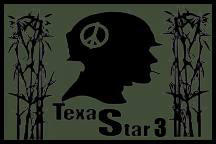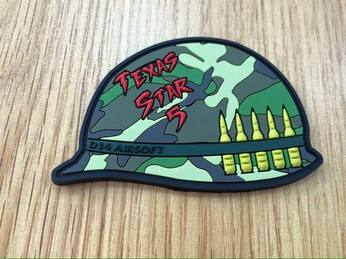
Operation Texas Star was a military operation of the Vietnam War in the A Shau Valley and the mountains east of the valley. It aimed at regaining the initiative in the area. The operation culminated in the Battle of Fire Support Base Ripcord, which ended by the fall of the FSB into the hands of the North Vietnamese on July 23, 1970.
Operation Texas Star during the Vietnam War took place from April 1, 1970 to September 5, 1970. Both the 101st Airborne Division and the ARVN 1st Infantry Division were involved in the operation. The operation took place mainly in the Western Quang Tri and Thua Thien Provinces of Vietnam.
President Nixon secretly began the withdrawal of troops from Vietnam early in 1969. As the only full-strength division remaining in Vietnam in early 1970, the 101st Airborne Division was ordered to conduct the planned offensive Operation Texas Star near the A Shau Valley.
On March 12, 1970, the 3rd Brigade, 101st began rebuilding abandoned Fire Support Base Ripcord which relied, as with most remote bases at the time, on a helicopter lifeline to get supplies in and the personnel out. The firebase was to be used for a planned offensive by the 101st to destroy NVA supply bases in the mountains overlooking the valley. Located on the eastern edge of the valley, and taking place at the same time as the Cambodian Incursion, the operation was considered covert.
As the 101st Airborne Division planned the attack on enemy supply bases, the North Vietnamese Army (NVA) was secretly observing their activities. From March 12 until June 30, the NVA was sporadically attacking the firebase. After weeks of reconnaissance by the NVA, on the morning of July 1, 1970 the North Vietnamese Army launched a mortar attack on the firebase. During the 23-day siege, 75 US servicemen were killed, including Colonel Andre Lucas, who was posthumously awarded the Medal of Honor; and First Lt. Bob Kalsu, the only contemporaneously active pro athlete to be killed during the war.[3]
Fighting from four hilltops, surrounded, and outnumbered nearly ten to one, U.S. forces caused heavy losses on eight enemy battalions, before an aerial withdrawal under heavy mortar, anti-aircraft, and small arms fire. After the U.S. Army withdrew from the firebase, USAF B-52 heavy bombers were sent in to carpet bomb the area.[4] Major General (ret) Ben Harrison, then the commander of the 3rd Brigade of the 101st Airborne at FSB Ripcord, is of the opinion that perhaps the NVA losses at Ripcord, just as their losses of their major offensives of the Ia Drang in 1965 and Tet in 1968, dulled the offensive capability of NVA for two full years, resulting in the delaying of their Easter Offensive from 1971 to 1972.
Operation Texas Star during the Vietnam War took place from April 1, 1970 to September 5, 1970. Both the 101st Airborne Division and the ARVN 1st Infantry Division were involved in the operation. The operation took place mainly in the Western Quang Tri and Thua Thien Provinces of Vietnam.
President Nixon secretly began the withdrawal of troops from Vietnam early in 1969. As the only full-strength division remaining in Vietnam in early 1970, the 101st Airborne Division was ordered to conduct the planned offensive Operation Texas Star near the A Shau Valley.
On March 12, 1970, the 3rd Brigade, 101st began rebuilding abandoned Fire Support Base Ripcord which relied, as with most remote bases at the time, on a helicopter lifeline to get supplies in and the personnel out. The firebase was to be used for a planned offensive by the 101st to destroy NVA supply bases in the mountains overlooking the valley. Located on the eastern edge of the valley, and taking place at the same time as the Cambodian Incursion, the operation was considered covert.
As the 101st Airborne Division planned the attack on enemy supply bases, the North Vietnamese Army (NVA) was secretly observing their activities. From March 12 until June 30, the NVA was sporadically attacking the firebase. After weeks of reconnaissance by the NVA, on the morning of July 1, 1970 the North Vietnamese Army launched a mortar attack on the firebase. During the 23-day siege, 75 US servicemen were killed, including Colonel Andre Lucas, who was posthumously awarded the Medal of Honor; and First Lt. Bob Kalsu, the only contemporaneously active pro athlete to be killed during the war.[3]
Fighting from four hilltops, surrounded, and outnumbered nearly ten to one, U.S. forces caused heavy losses on eight enemy battalions, before an aerial withdrawal under heavy mortar, anti-aircraft, and small arms fire. After the U.S. Army withdrew from the firebase, USAF B-52 heavy bombers were sent in to carpet bomb the area.[4] Major General (ret) Ben Harrison, then the commander of the 3rd Brigade of the 101st Airborne at FSB Ripcord, is of the opinion that perhaps the NVA losses at Ripcord, just as their losses of their major offensives of the Ia Drang in 1965 and Tet in 1968, dulled the offensive capability of NVA for two full years, resulting in the delaying of their Easter Offensive from 1971 to 1972.





